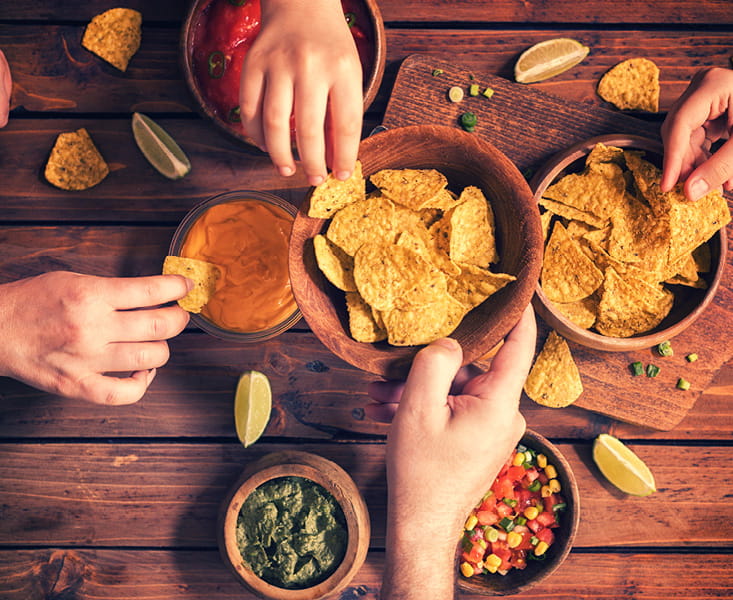Consumer Insight: Purchase Power of Today’s Teens
February 7, 2019
Click Here for the full report!
There are 54 million Americans in Generation Z, (aka Generation We / iGeneration). Teen and tween Gen Z kids, ages 10-17, account for $44 billion in discretionary spending each year. According to Forbes, they’re poised to become the largest generation of consumers by 2020, responsible for up to $143 billion of direct spending. They wield strong opinions, wide influence and have inherited their parents’ interest in healthy eating. Generation Z and teens in particular are already showcasing their adventurous palates, desire for functional food, and love of culinary self-expression. Let’s explore this group’s impact on the food and beverage industry.

Teens today are some of the busiest of any other generation, navigating life in an ever-changing world. Here are some key characteristics that set them apart and make them the next group of consumers to watch:
Teens in 2019 are intelligent and possess a strong sense of self. A recent Mintel report describes them as the most racially diverse group of Americans today. Constantly online and social, they’re passionate about their unique hobbies and interests: finding, sharing and seeking inspiration.
Having grown up in a digital world, teens and tweens of Generation Z are well-informed. Gathering information, and sifting through it to find sources and products they trust is second nature to them. According to Piper Jaffray, Snapchat, Instagram and Netflix win out over Facebook and YouTube with this young generation of avid self-teachers.
Even though most teens go through a rebellious phase, Gen Z teenagers tend to be more risk-adverse than other generations, and are less likely to experiment with drugs and alcohol. A Mintel report cites data from the National Institute on Drug Abuse showing long-term declines in the use of alcohol, tobacco, and some drugs among teens.
Risk adverse doesn’t necessarily mean that teens avoid adventure. Globally connected, this group is open to unique tastes and daring flavors. But they’re also more likely to follow brands that are well-reviewed by friends, because it’s also financially risky to stray too far from a trusted brand. (Mintel)

Because Generation Z kids prioritize academics, after school and summer break jobs are increasingly rare, and discretionary income is often very low.
Pragmatic: According to a Mintel report, more than 8 out of 10 teenagers of Generation Z describe themselves as responsible with the money they have, even though a majority of tweens and teens show interest in things they can’t yet afford. It’s likely that they may become even more discerning as adults, choosing quality over quantity as they gain more buying power.
Predictably, most of the money teens and tweens do have is spent on entertainment, food, and clothing. Piper Jaffray reports that food continues to be teens’ #1 spending category in 2018. So let’s take a look at what Gen Z takes into consideration when they have money to spend, and how that differs from their predecessors...
We already know that Millennials drum up big business in the food and beverage world; so how does the next generation stack up by comparison, and what’s important for manufacturers going forward with new products? For product developers, here are some interesting ways teens stand out.
Teens and tweens today view the food they eat and cooking as a form of self-expression. They enjoy preparing meals at home, eager to learn from how-to videos and shows. In contrast, Millennials strongly rely on the convenience of prepackaged food and meal plans. With a propensity for creativity, Z teens are big experimenters in the kitchen, mixing and matching ingredients to see what makes them happy.
Even more than Millennials, teens are interested in where their dollar goes, considering food waste, packaging, fair trade, food production, plant-based beef alternatives, sustainability, and human labor. Companies with greater transparency and an authentic commitment to similar values are in good shape to be noticed by these young consumers.
Gen Z teens are more racially diverse than Millennials. Not only do they make up various backgrounds and cultures, they’re interested in connecting with people of different shapes, sizes, and abilities, too. Often, they view different as not only better, but essential, and that’s also reflected in their food and beverage choices.
Research from Food Navigator suggests that at this early age, teenagers tend to be less nostalgic about food than the Millennials and other adults, preferring new or unconventional flavor pairings.
While image is still important, (a Mintel Social Media Trends Report reveals that 54% of teens still use Instagram)... Gen Z teens are not as interested in taking the most-liked photo for social media, something Millennials prioritized. Gen Z places greater importance on experiences and learning; they simply don’t always have the money to spend on the world’s prettiest ice cream cone. Products that incorporate experiences into their marketing, such as music festivals or concerts, may be more reachable to this group.

While moms and dads form their kids’ early perceptions of food and beverages, as Gen Z teens grow up, they become major influencers of their parents’ choices at the grocery store and in the kitchen.
Chances are good that teens and tweens who live at home have been raised to value heathy, natural eating and wellness from the get-go: 7 out of 10 teenagers say that they get their main food knowledge from their health-conscious parents. Clean label, organic products, and wellness is still a huge consideration here, even though it may take a back seat from time to time. Currently, teenagers are slightly less concerned with how healthy a food or snack is, compared to their parents, but this is sure to change as they grow up.
With only a small minority of teenagers paying for any of their own groceries and restaurant food, teenagers depend on their parents to make most of their purchases. However, that doesn’t mean parents make all the food decisions solo. Teens and tweens are huge influencers when it comes to what’s purchased. Forbes reports that 93% of parents say their children influence family and household purchases. According to Food Dive, parents say that up to one third of the weekly grocery bill is dictated by what, when, and how their teenagers like to eat.

Parents and today’s teens and tweens have a good relationship in the kitchen and are very comfortable preparing meals, learning from watching their parents and popular cooking shows on television
or online. A Food Dive brief reveals that Gen Z teenagers are most enthusiastic about making their own low-carb meals, low-fat meals and vegetarian entrées.
Additionally, teens have wider access to multicultural and ethnic foods. Over a third of parents with teenagers say their children enjoy international foods beyond the typical (to Americans) cuisines of Italian, Mexican, and Chinese.
When it comes to snacks, teens and tweens are more adventurous than any other generation. A recent Mintel report reveals that a majority of parents spend more money on snacks when shopping with their child, and that 84% of children enjoy trying new snacks.
It’s little wonder that Food Navigator predicts that the broad, sophisticated palates of teenagers means, “innovative, adventurous fusion and hybrid flavors is on the horizon.” Particularly popular products for Gen Z teens include frozen ethnic meals, sparkling water, ramen, yogurt, and plant-based beef alternatives.
As a Gen Z is less likely to experiment with alcohol, non-alcoholic, premium crafted non-alcoholic beverages may begin to edge out cocktails. Time will tell if that interest changes once they become legal age to drink. Gen Z teens are acutely aware of their own personal success and how others perceive them, so it’s possible that alcohol just doesn’t yet mesh with an online social presence. Still, they need something to drink when they socialize. As they age into adulthood, occasion-worthy, premium beverages and ‘mocktails’ are primed to take center stage.

We predict as well that teenagers’ desire for self-expression and multiculturalism may make limited-edition flavors and customizable combinations all the more popular in the coming years. Perhaps to express their individuality, Gen Z teens love discovering products that no one else has.
Finally, Generation Z teens continue to be interested in the trend of functional food, especially for snacking. With limited income, they need what they eat to fill them up until
the next meal, and then some. Snacks and beverages that offer athletic stamina, focus, or mental clarity alleviate the pressures of being in a highly competitive, academic environment.
Today’s teenagers have influence far beyond their often limited cash on hand. Though young, this group is signaling some clear opinions and passions for the future. The food and beverage industry would be wise to take note… Where are some opportunities? Limited edition flavors that create an experience and showcase individuality. Note also that like all other consumer groups, taste is the #1 priority for teens today. Yet functionality is also critical. Can it improve their microbiome, or sustain them through soccer practice? A discerning worldview makes teens today prioritize what they eat differently: Food production, sustainability, and cultural diversity are all big considerations. Brands with authentic alignment (emphasis on authentic) will grab this group’s attention.
Click Here for the full report!
What does true partnership look like? You deserve a flavor partner ready to turn these trends into the tangible.
Let FONA’s market insight and research experts get to work for you. Translate these trends into bold new ideas for your brand. Increase market share and get to your “what’s next.” Our technical flavor and product development experts are also at your service to help meet the labeling and flavor profile needs for your products to capitalize on this consumer trend. Let’s mesh the complexities of flavor with your brand development, technical requirements and regulatory needs to deliver a complete taste solution.
From concept to manufacturing, we’re here for you — every step of the way. Contact our sales service department at 630.578.8600 to request a flavor sample or visit www.mccormickfona.com/contact-mccormick-flavor-solutions for more information
Sources in full report
There are 54 million Americans in Generation Z, (aka Generation We / iGeneration). Teen and tween Gen Z kids, ages 10-17, account for $44 billion in discretionary spending each year. According to Forbes, they’re poised to become the largest generation of consumers by 2020, responsible for up to $143 billion of direct spending. They wield strong opinions, wide influence and have inherited their parents’ interest in healthy eating. Generation Z and teens in particular are already showcasing their adventurous palates, desire for functional food, and love of culinary self-expression. Let’s explore this group’s impact on the food and beverage industry.

Teens of Gen Z: Curious, Savvy, Risk-Adverse & Always on the Go
Teens today are some of the busiest of any other generation, navigating life in an ever-changing world. Here are some key characteristics that set them apart and make them the next group of consumers to watch:
Curious
Teens in 2019 are intelligent and possess a strong sense of self. A recent Mintel report describes them as the most racially diverse group of Americans today. Constantly online and social, they’re passionate about their unique hobbies and interests: finding, sharing and seeking inspiration.
Savvy
Having grown up in a digital world, teens and tweens of Generation Z are well-informed. Gathering information, and sifting through it to find sources and products they trust is second nature to them. According to Piper Jaffray, Snapchat, Instagram and Netflix win out over Facebook and YouTube with this young generation of avid self-teachers.
Less Risky
Even though most teens go through a rebellious phase, Gen Z teenagers tend to be more risk-adverse than other generations, and are less likely to experiment with drugs and alcohol. A Mintel report cites data from the National Institute on Drug Abuse showing long-term declines in the use of alcohol, tobacco, and some drugs among teens.
Risk adverse doesn’t necessarily mean that teens avoid adventure. Globally connected, this group is open to unique tastes and daring flavors. But they’re also more likely to follow brands that are well-reviewed by friends, because it’s also financially risky to stray too far from a trusted brand. (Mintel)

Teens & Money
Because Generation Z kids prioritize academics, after school and summer break jobs are increasingly rare, and discretionary income is often very low.
Pragmatic: According to a Mintel report, more than 8 out of 10 teenagers of Generation Z describe themselves as responsible with the money they have, even though a majority of tweens and teens show interest in things they can’t yet afford. It’s likely that they may become even more discerning as adults, choosing quality over quantity as they gain more buying power.
Predictably, most of the money teens and tweens do have is spent on entertainment, food, and clothing. Piper Jaffray reports that food continues to be teens’ #1 spending category in 2018. So let’s take a look at what Gen Z takes into consideration when they have money to spend, and how that differs from their predecessors...
Food & Beverage: How do teens differ from Millennials?
We already know that Millennials drum up big business in the food and beverage world; so how does the next generation stack up by comparison, and what’s important for manufacturers going forward with new products? For product developers, here are some interesting ways teens stand out.
Teens and tweens today view the food they eat and cooking as a form of self-expression. They enjoy preparing meals at home, eager to learn from how-to videos and shows. In contrast, Millennials strongly rely on the convenience of prepackaged food and meal plans. With a propensity for creativity, Z teens are big experimenters in the kitchen, mixing and matching ingredients to see what makes them happy.
Diversity & Sustainability
Even more than Millennials, teens are interested in where their dollar goes, considering food waste, packaging, fair trade, food production, plant-based beef alternatives, sustainability, and human labor. Companies with greater transparency and an authentic commitment to similar values are in good shape to be noticed by these young consumers.
Gen Z teens are more racially diverse than Millennials. Not only do they make up various backgrounds and cultures, they’re interested in connecting with people of different shapes, sizes, and abilities, too. Often, they view different as not only better, but essential, and that’s also reflected in their food and beverage choices.
Experiential
Research from Food Navigator suggests that at this early age, teenagers tend to be less nostalgic about food than the Millennials and other adults, preferring new or unconventional flavor pairings.
While image is still important, (a Mintel Social Media Trends Report reveals that 54% of teens still use Instagram)... Gen Z teens are not as interested in taking the most-liked photo for social media, something Millennials prioritized. Gen Z places greater importance on experiences and learning; they simply don’t always have the money to spend on the world’s prettiest ice cream cone. Products that incorporate experiences into their marketing, such as music festivals or concerts, may be more reachable to this group.
- 21% have less interest in portraying an image to others
- 29% have more interest in seeking out educational opportunities
- 17% are more open to diversity, different, ideas, cultures, and people

The Teen & Parent Connection
While moms and dads form their kids’ early perceptions of food and beverages, as Gen Z teens grow up, they become major influencers of their parents’ choices at the grocery store and in the kitchen.
Chances are good that teens and tweens who live at home have been raised to value heathy, natural eating and wellness from the get-go: 7 out of 10 teenagers say that they get their main food knowledge from their health-conscious parents. Clean label, organic products, and wellness is still a huge consideration here, even though it may take a back seat from time to time. Currently, teenagers are slightly less concerned with how healthy a food or snack is, compared to their parents, but this is sure to change as they grow up.
With only a small minority of teenagers paying for any of their own groceries and restaurant food, teenagers depend on their parents to make most of their purchases. However, that doesn’t mean parents make all the food decisions solo. Teens and tweens are huge influencers when it comes to what’s purchased. Forbes reports that 93% of parents say their children influence family and household purchases. According to Food Dive, parents say that up to one third of the weekly grocery bill is dictated by what, when, and how their teenagers like to eat.

Teens in the Kitchen
Parents and today’s teens and tweens have a good relationship in the kitchen and are very comfortable preparing meals, learning from watching their parents and popular cooking shows on television
or online. A Food Dive brief reveals that Gen Z teenagers are most enthusiastic about making their own low-carb meals, low-fat meals and vegetarian entrées.
Additionally, teens have wider access to multicultural and ethnic foods. Over a third of parents with teenagers say their children enjoy international foods beyond the typical (to Americans) cuisines of Italian, Mexican, and Chinese.
Test Kitchen Cookbook for Young Chefs
As evidence of tween and teen interest in cooking and experimenting with food, look no further than the success of The Complete Cookbook for Young Chefs, from America’s Test Kitchen. The book is filled with recipes for young aspiring cooks and it debuted on the New York Times bestseller list, to rave reviews from parents. Reviewers like that the book doesn’t talk down to kids and teens while creating a simple and enjoyable bridge to the culinary arts.
- 20% of Generation Z teens use cooking as a way to unleash creativity
- 46% of teenagers watch cooking shows on a regular basis
- 3x tween and teen members of Generation Z participate in meal prep at least 3 times per week
The Power of Snacks
Teenagers are a hungry bunch. According to a national survey commissioned by Farm Rich of 2,000 families with teenagers, kids between the ages of 13 and 19 spend an average of 1,000 hours each year thinking about food. That’s 39 days!
Here’s what else the survey discovered:
- Kids and teens eat 2-3 snacks per day between meals.
- Top choices include chips, fruit, pizza, and frozen snacks.
- Teens prefer foods that will tide them over until the next meal.
When it comes to snacks, teens and tweens are more adventurous than any other generation. A recent Mintel report reveals that a majority of parents spend more money on snacks when shopping with their child, and that 84% of children enjoy trying new snacks.
It’s little wonder that Food Navigator predicts that the broad, sophisticated palates of teenagers means, “innovative, adventurous fusion and hybrid flavors is on the horizon.” Particularly popular products for Gen Z teens include frozen ethnic meals, sparkling water, ramen, yogurt, and plant-based beef alternatives.
More mocktails, please...
As a Gen Z is less likely to experiment with alcohol, non-alcoholic, premium crafted non-alcoholic beverages may begin to edge out cocktails. Time will tell if that interest changes once they become legal age to drink. Gen Z teens are acutely aware of their own personal success and how others perceive them, so it’s possible that alcohol just doesn’t yet mesh with an online social presence. Still, they need something to drink when they socialize. As they age into adulthood, occasion-worthy, premium beverages and ‘mocktails’ are primed to take center stage.

Limited Editions & Function Friendly
We predict as well that teenagers’ desire for self-expression and multiculturalism may make limited-edition flavors and customizable combinations all the more popular in the coming years. Perhaps to express their individuality, Gen Z teens love discovering products that no one else has.
Finally, Generation Z teens continue to be interested in the trend of functional food, especially for snacking. With limited income, they need what they eat to fill them up until
the next meal, and then some. Snacks and beverages that offer athletic stamina, focus, or mental clarity alleviate the pressures of being in a highly competitive, academic environment.
The Takeaways
Today’s teenagers have influence far beyond their often limited cash on hand. Though young, this group is signaling some clear opinions and passions for the future. The food and beverage industry would be wise to take note… Where are some opportunities? Limited edition flavors that create an experience and showcase individuality. Note also that like all other consumer groups, taste is the #1 priority for teens today. Yet functionality is also critical. Can it improve their microbiome, or sustain them through soccer practice? A discerning worldview makes teens today prioritize what they eat differently: Food production, sustainability, and cultural diversity are all big considerations. Brands with authentic alignment (emphasis on authentic) will grab this group’s attention.
Click Here for the full report!
You deserve more. Let’s get started.
What does true partnership look like? You deserve a flavor partner ready to turn these trends into the tangible.
Let FONA’s market insight and research experts get to work for you. Translate these trends into bold new ideas for your brand. Increase market share and get to your “what’s next.” Our technical flavor and product development experts are also at your service to help meet the labeling and flavor profile needs for your products to capitalize on this consumer trend. Let’s mesh the complexities of flavor with your brand development, technical requirements and regulatory needs to deliver a complete taste solution.
From concept to manufacturing, we’re here for you — every step of the way. Contact our sales service department at 630.578.8600 to request a flavor sample or visit www.mccormickfona.com/contact-mccormick-flavor-solutions for more information
Sources in full report




